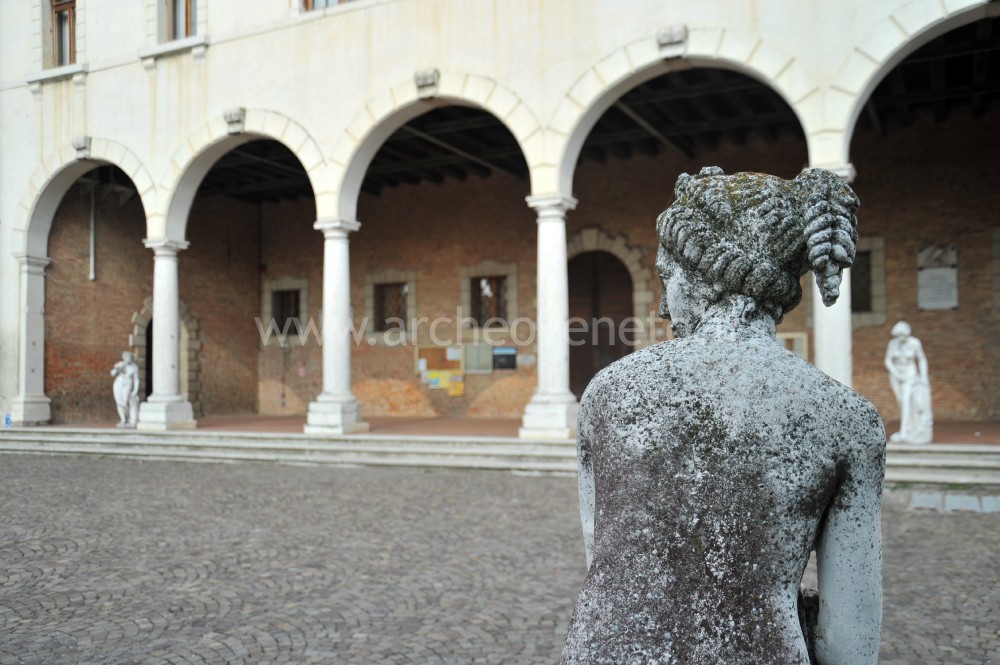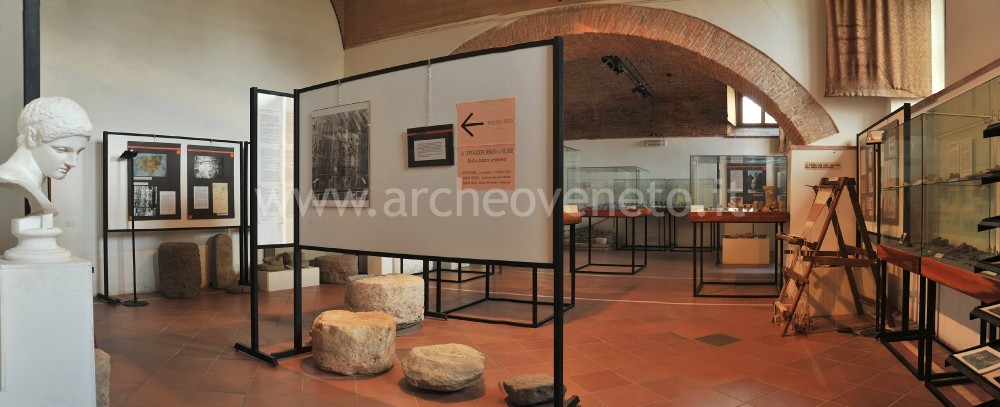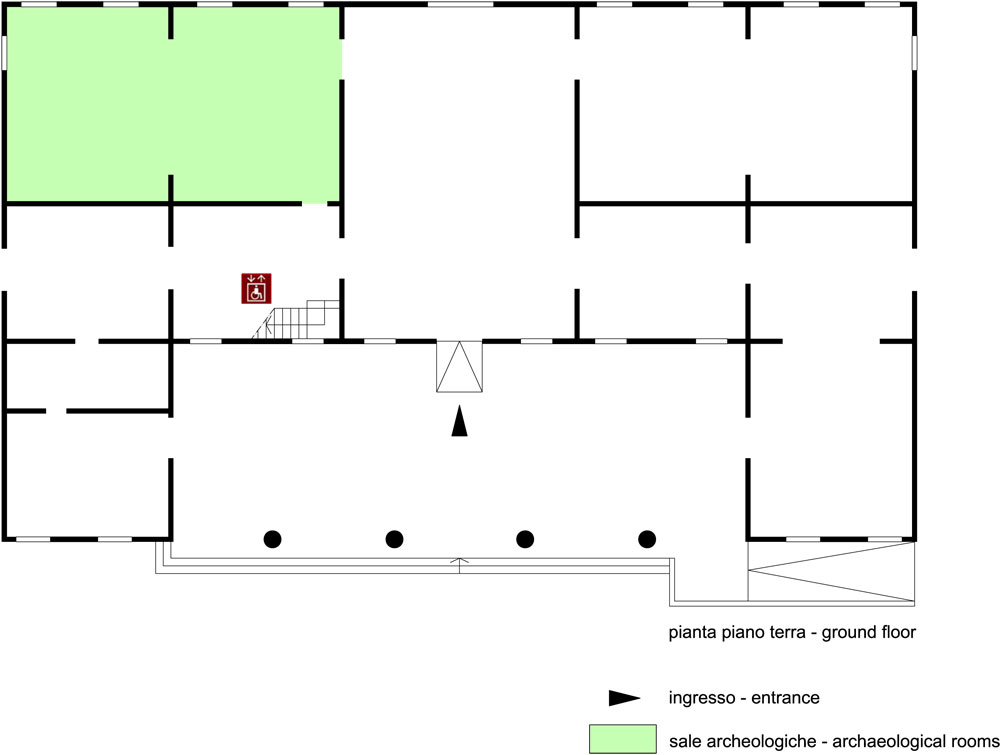|
|
File
Museum of the Roman Centuriation – Villadose
|
Piazza Moro 1 (Municipio, piano terra) – 45010 Villadose (RO)
– Fax 0425 90322 |
  |
|
Summary

The museum of Villadose displays approximately 400 finds discovered thanks to the field walking activities carried out in the large centuriation area stretching between Adria and Villadose. Thanks to aerial photographs and systematic research campaigns, the local Archaeological Group has been able to identify in this area about 340 sites of the pre-roman and roman age. The exhibition is organized into four sections: centuriation and field walking, the activities carried out by the settlers in the centuriation; the results of the research currently going on and the finds referring to the ancient people of Veneto living in Villadose.
Collection history
The study of the aerial photographs carried out in the 60’s led to the hypothesis that the division of the farm land dates back to the Roman age. The first essay addressing the topic scientifically was written in 1984 by Raffaele Peretto and Enrico Zerbinati; thanks to their work and the following field walking activities, in 1990 it was possible to establish the museum in the Patella Palace, the current seat of the Town Hall of Villadose. The surveys went on also in the following years. In particular between 2002 and 2004, in Pontecchio Polesine, a settlement was discovered dating back to the middle Bronze Age in the site of Zanforlina and remains of a country villa of the early imperial age were found in the site of Cà Motte.
|

 The first section of the room is devoted to the topic of centuriation. Panels and aerial photographs explain the role of surveyors, the features of centuriation and its function. As the exhibition goes on, panels provide more detailed information, focusing in particular on the case study of Adria and Villadose and they are accompanied by trachyte stones discovered thanks to the field walking activities carried out in the site Livello (Villadose). Then an explanation is provided on the methods adopted to investigate this specific archaeological context through systematic activities of field survey and the interpretation of the aerial photographs, which have led to the discovery of ancient roads that had been buried and of old field divisions. The first section of the room is devoted to the topic of centuriation. Panels and aerial photographs explain the role of surveyors, the features of centuriation and its function. As the exhibition goes on, panels provide more detailed information, focusing in particular on the case study of Adria and Villadose and they are accompanied by trachyte stones discovered thanks to the field walking activities carried out in the site Livello (Villadose). Then an explanation is provided on the methods adopted to investigate this specific archaeological context through systematic activities of field survey and the interpretation of the aerial photographs, which have led to the discovery of ancient roads that had been buried and of old field divisions.
The second section of the room displays objects related to the economic activities carried out in the centuriation, such as farming, brick making, stock breeding, trade, spinning and weaving.
The first activity presented more in detail is brick making. It is possible to see different kinds of stamped tiles and bricks coming from both private and imperial kilns. Next to them, the part of the exhibition devoted to brick making is complemented by some column bricks from the site Casonetto, a set of small tiles making up a floor surface (opus spicatum) and the reconstruction of a well made of arched bricks.
The following part of the exhibition regards the ancient coins found in Villadose; research activities have led to the discovery of approximately 500 coins related to a time span covering as many as 6 centuries (2nd cent. B.C.- 4th cent. A.D.). The display case next to the explanatory panel contains coins mainly referring to the transition phase between the declining republican age and the first two centuries of the Empire.
The section devoted to the dwellings (and to the activities carried out here) is the part of the museum displaying the largest amount of finds. The discovery of stone material (fragments of Euganean trachytes used for building), mosaic tiles, painted plaster and fragments of architectural decorations (marble covering slabs of different kinds and the fragment of an earthen antefix) has allowed the identification of the pars urbana of numerous country villas located in the area divided into centuriae. Other two important items are the hemispherical sundial (hemicyclium) found in the site Bernadetta in Mardimago and the fragment of a statuette with a shield from Sarzano.
A small section of the museum focuses on Roman burials and religious practices. Here it is possible to see the lower parts of some trachyte funerary urns, the reconstruction of a burial in cist containing its grave goods (glass unguentaria and a funerary urn) and some (mainly metal) artefacts of uncertain function, which are very likely to be related to religious rituals.
The exhibition goes on addressing topics linked to the domestic life, such as body care, games, farming and stock breeding.
Information on stock breeding is provided by the remains of bones (and horns) of farm animals (pigs, cattle and horses) and by the discovery of bricks with animal footprints.
The production of earthenware is the activity about which the largest amount of finds is available; indeed there are different kinds of ceramic vessels, which be classified according to their shape, but above all according to their function. First of all there is a set of transport vessels (mainly tips and necks of stamped amphoras) and lamps, which can be seen in a large display case. Then it is possible to see earthen objects related to food cooking and consumption, which are contained in the large display case in the middle of the room. Here there are examples of table pottery (fragments of sigillata plates, a graffito black varnish bowl and a thin-walled grey cup), glass items (fragments of multicolour vases, unguentaria, glasses and stamped bottles), bronze dinnerware objects (a spoon, a ladle handle, a saucepan and small vessels) and cookware (jugs, utilitarian pot bottoms and lids).
The importance of weaving if proved by the remarkable amount of objects related to this activity, such as numerous earthen loom weights and spindle whorls. The reconstruction of a vertical loom enables visitors better to understand its functioning.
The second last display case contains finds of the Roman period (small bronzes and iron tools), whereas the last one displays materials related to the civilization of Veneto from about twenty sites, which at a later stage, were occupied by settlements linked to the Roman centuriation. Here it is possible to see grey pottery, small bronzes portraying devotees, horses and praying people, votive tablets, a miniature helmet of Veneto, a Venetic drachma of the 2nd cent. B.C. and a small bronze head from the site Cagna.
|

Admission: Su prenotazione
Ticket: No
 School access School access
 Disabled access Disabled access
Opening Days
| Tipology |
When |
Specs |
| Summer/Winter |
Monday |
Upon reservation |
| Summer/Winter |
Tuesday |
Upon reservation |
| Summer/Winter |
Wednesday |
Upon reservation |
| Summer/Winter |
Thursday |
Upon reservation |
| Summer/Winter |
Friday |
Upon reservation |
| Summer/Winter |
Saturday |
Upon reservation |
| Summer |
Sunday |
Upon reservation |
Recommended tour time (minutes): 45
 Toilet Toilet
 Parking Parking
 Guide a stampa Guide a stampa
Brochure
Italian
 Information boards Information boards
Italian
 Captions under exhibits Captions under exhibits
Italian
 Guided Tours Guided Tours
 Educational activities Educational activities
 Library and documentation centre Library and documentation centre
| La centuriazione romana a Villadose 1990, a cura di Gruppo Archeologico di Villadose, Villadose. |
| La ricerca archeologica di superficie in area padana 1996, a cura di Maragno E., Stanghella. |
| Facchini G.M. 2006, Villadose in età romana II, Stanghella. |
| Bonetto J. 2009, Veneto (Archeologia delle Regioni d’Italia), Roma, pp. 389. |
|

